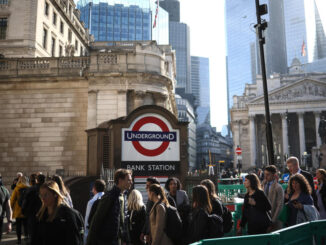
Nobody knows what’s going to happen with the economy. That’s always true, but especially in 2023. And it’s not just a matter of uncertainty: There’s a plausible case that we face three mutually exclusive scenarios.
Either we face a “hard landing,” where rising interest rates push the US into a recession; a soft landing, where the Federal Reserve and policymakers can bring down inflation without crashing the economy; or no landing at all — the economy grows even faster with inflation staying high.
The soft landing scenario is the one policymakers would most like to see — it would mean the US brought down inflation while ensuring a strong labor market.
The level of optimism about a soft landing was always wavering; in the last month it even briefly seemed realistic, until a series of data revisions and new numbers brought a revival of pessimism. The Commerce Department said Friday that the Personal Consumption Expenditures price index, the Fed’s preferred measure of inflation, had climbed 5.4 percent in January, suggesting inflation isn’t slowing down as much as previously thought.
It’s not time to despair yet. A soft landing is still possible, but pulling it off will depend on a lot of factors, and the consequences of failing are severe.
Previously on “The Economy”
The economic recovery since 2021 has had two major features: the strongest labor market in 50 years, and inflation that’s been higher and broader than most analysts predicted. Inflation first rose in the summer of 2021 for some goods affected by pandemic shutdowns and weakened supply chains, notably automobiles. It soon broadened to more categories, including services. From September 2021 to September 2022, core consumer price index (CPI) inflation saw a 6.6 percent increase, well above pre-pandemic levels.
As 2022 went on, supply chains began to normalize, and housing and rental prices began to fall. This, however, led to a measurement issue when it came to inflation. Just because used car prices fell, did it mean the country was seeing a sustained drop in inflation? What about housing prices, which have a significant lag — meaning inflation can be measured as higher for a period even as housing prices are falling?
Over the fall of 2022, officials at the Federal Reserve came up with an answer to gauge this: Look at services, excluding housing, with the idea that inflation in non-housing services is most sensitive to demand. If they saw this come down, they would understand progress was being made. And progress looked like it was happening.
Over the last several months of 2022, the US saw a remarkable decline in inflation. It looked like core inflation fell by over half, from around 6.5 percent to 3 percent. However, that optimism soon ran into two problems. First was a series of revisions to the seasonal adjustment methodology that the BLS uses — it turns out that inflation had fallen less than anyone thought, more like a decline of 4 percent to 4.5 percent.
Second was new January numbers for inflation, with core CPI inflation for that month around 5 percent on an annual basis — still lower than a year ago, but now moving sideways rather than downward. The sense of momentum toward the endgame of fighting inflation suddenly was replaced with a feeling of being stuck in the middle.
So what happens next? There are three paths forward; let’s start with the worst option.
Engineering a recession is like tearing fabric
Will the Federal Reserve respond to this pessimism about a soft landing by causing a recession? This is still the consensus forecast call, although it’s less of a certainty than it seemed in October 2022, when 100 percent of economists surveyed by Bloomberg said the US would have a recession within the year.
To be clear, there’s no evidence that the country is in a recession now or that it was in one in 2022. Unemployment is continuing to drop while overall growth remains robust. That’s the opposite of how economists normally characterize a recession.
But there are enough cracks to see how things could change quickly. Investment has fallen dramatically and may continue to fall. Consumer spending started to decline in late 2022, though it remains strong. Labor market indicators, such as the rate at which people quit their jobs or the level of wage gains, had been slowing throughout last year.
The Federal Reserve says it wants unemployment to increase. Its most recent compilation of projections found that, through its actions, unemployment will increase to 4.6 percent. That would translate into around 2 million people losing their jobs — pain that would not be evenly felt. The last time the unemployment rate was around 4.6 percent, in October 2021, 7.7 percent of Black workers were unemployed, compared with 4 percent of white workers.
And that assumes it’s even possible for the Federal Reserve to raise unemployment just a little bit. But as researchers at Employ America have found, any time unemployment goes up 1 percent, it tends to keep going up much further. There’s no way, historically, to cause a tiny recession; once unemployment starts increasing, it just keeps increasing. The metaphor isn’t turning down the heat on a stove; as Nancy Teeters, the sole dissenter against then-Federal Reserve chair Paul Volcker’s hikes in the early 1980s, described, it’s “pulling the financial fabric of this country so tight that it’s going to rip. You should understand that once you tear a piece of fabric, it’s very difficult, almost impossible, to put it back together again.”
The “never never land” scenario
Yet, at least among a set of financial analysts, the question isn’t whether there’s a hard or soft landing, it’s why there’d be any landing at all. After the recent January blockbuster number of 517,000 new jobs, this theory was floated in the New York Times, the Wall Street Journal, and on Bloomberg’s opinion page. This “no landing” scenario predicts that the economy is likely to rebound even further in 2023, with growth picking up and inflation likely staying the same or even increasing.
There are several pieces of evidence for this argument: predictions of increased GDP growth in early 2023, the possibility of a slight rebound in the housing market, and an increase in real wages, with inflation falling faster than wage growth in the second half of 2022. A large increase to Social Security payments, along with the new year being a reason for workers to ask for higher wages and firms to increase their prices, could also contribute to further demand increases.
As financial analyst Matt Klein writes, “The good news is that the humming economy continues to provide more opportunities for more people to produce more of the things we need and want. The bad news is that it seems increasingly unlikely that America will return to pre-pandemic inflation rates without a downturn.”
But not all the evidence points in this direction. Economist Justin Bloesch argues that the things we’d expect to be most sensitive to a reaccelerating economy — the number of housing starts, notably — aren’t there. We should distinguish between an economy that is doing well versus one that is accelerating. Job increases coming from more workers entering the labor force, while wages grow more slowly, is a sign of a soft landing, not of no landing at all.
A central disagreement is how quickly the Federal Reserve’s rate hikes are acting to slow the economy. Those who think a recession is coming believe that the rate hikes, which increased the most over the summer and fall of 2022, take a while to take full effect, perhaps on the order of a year or two. Others, including those who wonder if there will be no landing, argue that the impact moves far more quickly. It is disconcerting that there’s so much ambiguity about this central question, but it’s tough to measure.
So how does the country get a soft landing?
Between these extremes of an economy too hot and too cold, is there hope for the Goldilocks just-right scenario? It was not clear whether a soft landing was a real option, a blind hope, or a cynical ploy when it was floated by Fed chair Jerome Powell and others around March 2022. As Powell told Marketplace in May 2022, he believed the labor market was so strong that you could decrease demand and inflation and that it would result in fewer job switchers and firms hiring, rather than higher unemployment.
Later that year, Powell backed away from that language and the Fed is now predicting a rise in unemployment that would be hard to see as consistent with a soft landing. But others think a soft landing is possible; as the economist Alan Blinder has documented, it has been done before. The US has already seen inflation drop by one-third without any cost to employment or economic activity. As Powell predicted, job openings declined, wages are still increasing at healthy but lower levels, and inflation has come down.
But what would have to happen in 2023 for this to continue? Roughly, about five things.
First, the country needs to see advancement on the developments that we know will slow inflation: more productivity and reduced corporate margins and profits. Over the past two years, many people have switched their jobs, moving into higher-skilled and higher-paying roles. Though it takes time, this welcome development should ultimately lead to higher productivity and, thus, lower inflation. Meanwhile, corporate profits remain near record highs because prices are being set higher than the cost of production, which translates into higher inflation for everyday people. If these profits were to come down, either from prices coming down or workers pushing up the share of corporate income going to labor, it would help bring down inflation.
Second, prices for goods would have to remain contained. There’s an assumption that goods are seeing prices in free-fall as supply chains open up, but that is driven entirely by used car prices; prices for most other goods are still increasing. As demand for used cars comes back — the US is still producing fewer cars than expected without the pandemic — this will likely remain a volatile category. If goods continue to contribute an extra half point to inflation, it’s not clear what will balance it out, unless incomes and spending in our majority-services economy become permanently weaker.
Third, the labor market needs to continue to pull workers into the labor force while having strong but not accelerating wage growth. The backlog in construction means employment there could stay strong even as those parts of the economy cool. Related, fourth, is that demand for housing doesn’t take off again, driving prices higher. There’s significant disagreement about how quickly we should understand the housing market to be cooling. But that it’s not accelerating is part of the case for decline.
Finally, the Fed needs to acknowledge the trade-offs it’s facing. Inflation is coming down, though it remains too high. But, as the Fed wants to bring down inflation, it should ask itself how quickly and at what cost. There was no set inflation target during the disinflation of the 1980s and 1990s, and there are many reasons why a larger inflation range of 2 to 3.5 percent makes more sense than the firm 2 percent the Fed is currently emphasizing. More research, including recent work by the Federal Reserve Bank of Cleveland, emphasizes the trade-offs.
When inflation was as high as it was in early 2022, it was hard to balance these concerns. Now, in 2023, it’s essential we do.
Source: www.vox.com



